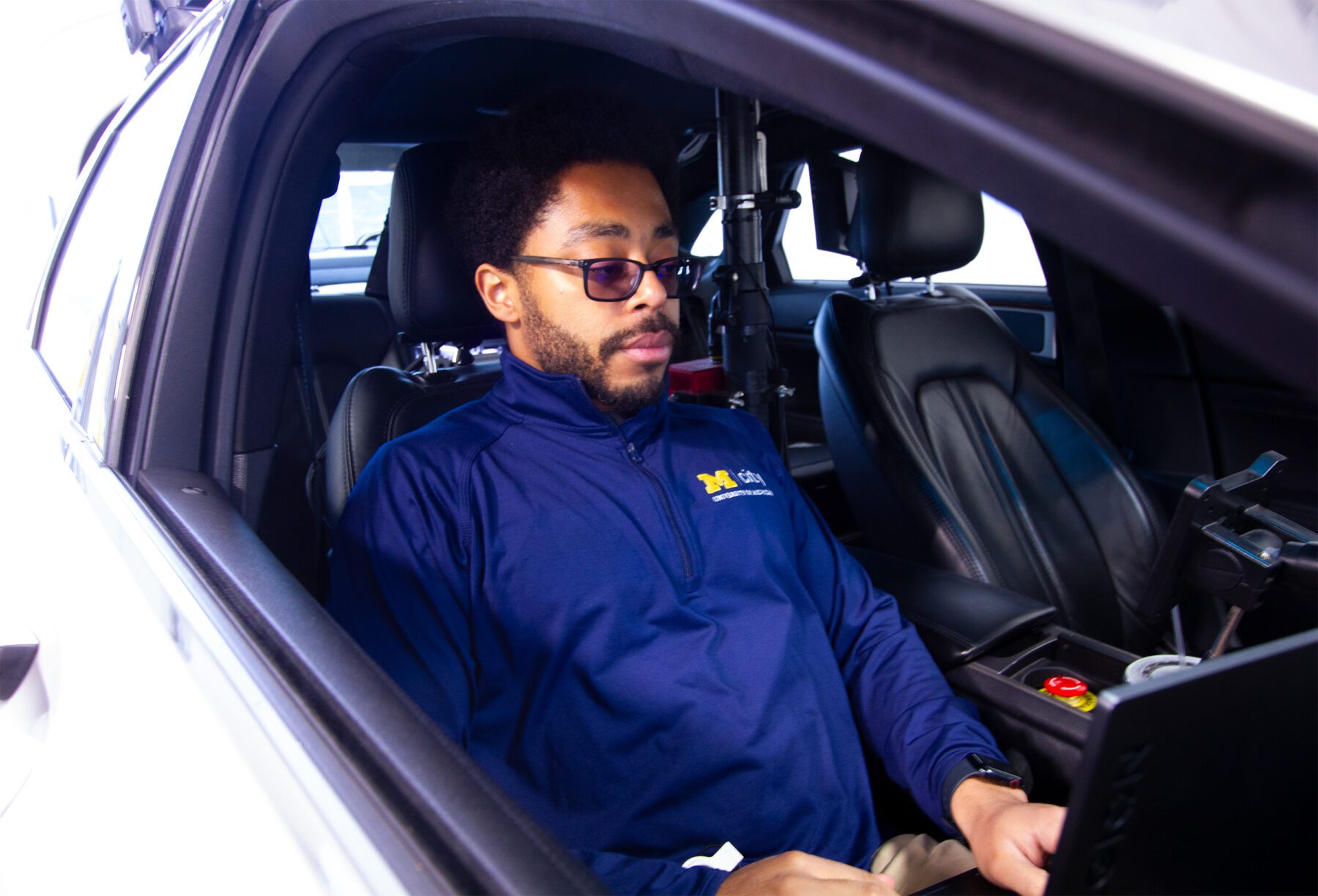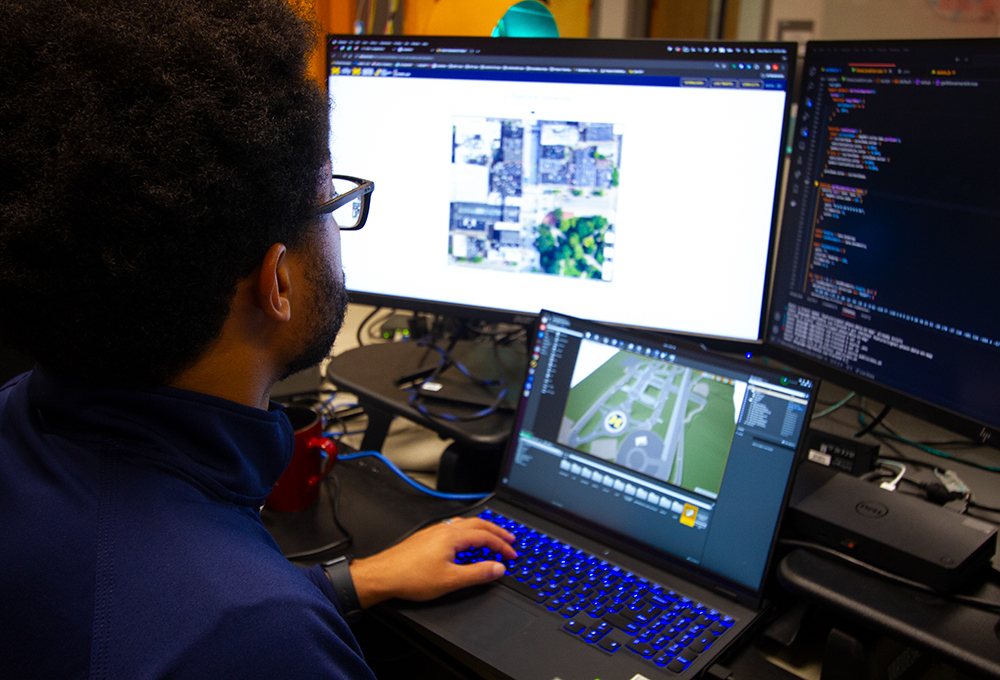Would-be film animator finds creative outlet as software engineer

MCITY STAFF SPOTLIGHT
If you’re heading out to watch an animated movie, you might want to hope you don’t end up sitting next to Darian Hogue.
Darian, 27, is a software engineer on the Mcity engineering team. After graduating from the University Prep Science & Math High School in Detroit, Darian headed to Eastern Michigan University in nearby Ypsilanti to study 3-D simulation and animation and picked up a minor in software engineering. He had his eye on the movies.
“I was going to work on feature films but I chose to pivot to software engineering because a lot of the 3-D animation work is contract-based,” Darian said.” The work can be pretty inconsistent. You may be hired for three months for a half a scene and then you’ve got to look for another job.”
Hollywood’s loss is Mcity’s gain.
After leaving EMU in 2017, Darian took advantage of free online courses in software engineering from Harvard University and the Massachusetts Institute of Technology. To add to his self-taught skills, he signed up for the software engineering program offered by Hack Reactor, which was established in San Francisco in 2012 and is a highly regarded online coding boot camp for students who want to become full-time software engineers. After boot camp, Hack Reactor asked Darian to stay on to mentor other students.
“When I graduated from the boot camp, my classmates voted me top of class because I’d tutored some struggling students,” Darian said. “Some of my mentors reached out to me to teach for about four months.”
While mentoring at Hack Reactor, Darian worked with friends to launch an e-commerce platform aimed at third-party vendors selling clothing. That project stalled and, four months later, he joined Mcity, happy to embrace steady employment creating software for Mcity’s cutting-edge autonomous vehicle testing facility.
Which is not to say Darian lost his appreciation for cutting-edge animation.
“It’s something I talk about with my wife all the time,” Darian admits. “I always talk about the timing, spacing, weight, and how realistic is it? Are you tricking the mind to think that that weight is real and then all the special effects? I always like to look into that and I really admire the animation team that did ‘Spider-Man: Across the Spider-Verse’ and what they’ve done with a lot of 2-D animation mixed with 3-D and making it collide in a really unique style.”
“I really admire the animation team that did ‘Spider-Man: Across the Spider-Verse’ and what they’ve done with a lot of 2-D animation mixed with 3-D and making it collide in a really unique style.”
Darian Hogue, software engineer, Mcity
Helping to ensure that self-driving vehicles don’t collide is one benefit of Darian’s work at Mcity, especially his current project involving what’s known as the Smart Intersections Project. The mission of the project, a collaboration among Mcity, U-M’s Michigan Traffic Lab, and the U-M Transportation Research Institute, is to is to improve the way vehicles are connected to each other and to the infrastructure to accelerate connected and automated vehicle (CAV) deployment. Smart intersections will be needed to safely guide CAVs through city traffic.

Through the use of cameras and sensors, the flow of vehicles, bicycles and pedestrians can be measured and analyzed, with the resulting data used to adjust traffic signals and warn CAVs as conditions change. If, for example, a large group of pedestrians was crossing a smart intersection, vehicles and traffic signals would receive data so they could adjust to avoid accidents, near-misses and other safety conflicts.
Part of Darian’s work is to make those smart intersections smarter. That’s not an easy task, considering that the Smart Intersections Project, which is funded by the Federal Highway Administration, covers around 75 Ann Arbor intersections. That includes a roundabout at State Street at Ellsworth Road that may be the most dangerous intersection in Washtenaw County, with nearly 100 crashes since the project started in May 2021.
“I built a front end app from the ground up to view that information, along with a tool to speed up human-in-the-loop validation for the Michigan Traffic Lab’s conflict detection AI training,” Darian said. “We have sensors at the roundabout on State and Ellsworth that use an algorithm to detect conflicts. Once the AI says, ‘Hey, I think I found a conflict,’ the system saves that information. Then the front-end application I work on allows users to view that recorded incident, and confirm or deny whether it actually is a conflict. That information is then used to train that algorithm to be more accurate the next time around.”
Even though he’s not creating the next Marvel Universe character or the next Pixar hit, Darian does get to use his graphic skills at Mcity, creating a 3-D map for the development of a simulated test facility.
“My map is acting as a temporary map for the internal team until we get our finalized version from a third party partner,” Darian said. “We wanted something sooner so we can just play around with the technology to get used to the tools that we’ll be receiving from the third party vendor. It came out pretty nice.”
Darian added a very different type of programming to his life in February last year when he and Deyja, a beauty aesthetician and his wife of seven years, welcomed a daughter, Amoura.
“It’s actually been a pretty smooth process, as of a couple months ago,” Darian says. “We got a little routine going on and understanding what she needs and wants. So, as of right now, we have our feet under us and we’re just preparing for the next set of changes.”
There’s no shortage of changes at Mcity, either. Darian’s other projects include upgrading the Mcity OS user interface; mirroring a physical vehicle onto the Mcity Test Facility’s 3D simulated map and incorporating traffic light data into the smart intersections web app. Plus, Darian is always looking for ways to enhance his knowledge of the industry and stay abreast of developments related to autonomous vehicles.
“That’s why I like software,” Darian says. “I’m always learning new things, get to keep up with cool tech, try out new technologies and implement them in production code. Software engineers can express our creative side because we have a lot of say when it comes to implementation of the applications. It’s not just, “Do this, do that.” Instead, it’s, ‘What do you think should go here and why?’ We can really dig deep into the problem and have our own creative freedom.”
“Software engineers can express our creative side because we have a lot of say when it comes to implementation of the applications. It’s not just, “Do this, do that.” Instead, it’s, ‘What do you think should go here and why?’ We can really dig deep into the problem and have our own creative freedom.”
Darian Hogue, software engineer, Mcity
With the continuous, rapid changes taking place in autonomous vehicle research, including the increased potential offered by artificial intelligence, Darian should have no shortage of outlets for creative programming solutions.
“There’s a lot of moving parts here at Mcity, and what I’m doing right now is helping the researchers get closer to their goal by developing tools that will speed up development,” Darian said. “It’s really a great time to be working at Mcity right now.”
This story was written by Brian J. O’Connor, a Michigan-based freelance writer.